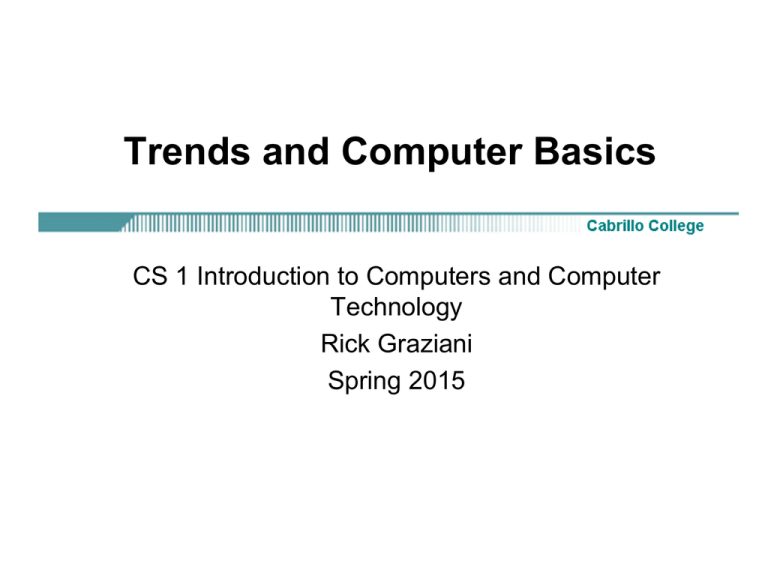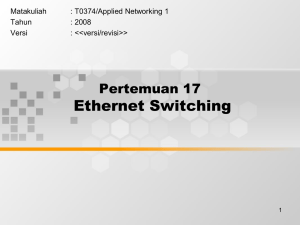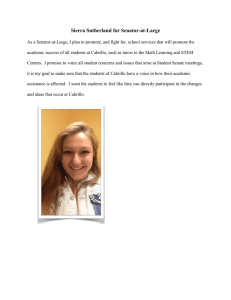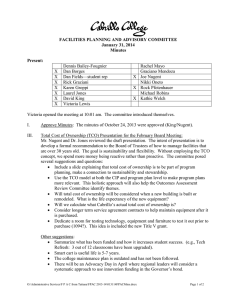Trends and Computer Basics CS 1 Introduction to Computers and Computer Technology
advertisement

Trends and Computer Basics CS 1 Introduction to Computers and Computer Technology Rick Graziani Spring 2015 Computer Science • Computer Science: The discipline that seeks to build a scientific foundation for such topics as: – computer design – computer programming – information processing – algorithmic solutions of problems Rick Graziani graziani@cabrillo.edu 2 Role of Algorithms Hardware Software Programming Program Algorithm • • • • • Algorithm: A set of steps that defines how a task is performed Program: A representation of an algorithm Programming: The process of developing a program Software: Programs and algorithms Hardware: Equipment used to input information (data) and output the results of the programs, algorithms. Rick Graziani graziani@cabrillo.edu 3 An algorithm for a magic trick Rick Graziani graziani@cabrillo.edu 4 History of Algorithms • • • The study of algorithms was originally a subject in mathematics. Early examples of algorithms – Long division algorithm – Euclidean Algorithm Let’s take a look at Euclidean Algorithm – Just to see that YOU can do this stuff! Rick Graziani graziani@cabrillo.edu 5 The Euclidean algorithm • Euclidean algorithm (also called Euclid's algorithm) is an algorithm to determine the greatest common divisor (GCD) of two elements. – One of the oldest algorithms known, dating back to the ancient Greeks. Euclid, 300 BC, "The Father of Geometry“ was a Greek – Greatest common divisor (GCD): The mathematician largest positive integer that divides both numbers without remainder – I.e. The largest number that can go into two numbers evenly. • Examples: – 15 and 6, the GCD is 3 • 15 / 3 = 5 6/3=2 – 48 and 40, the GCD is 8 • 48 / 8 = 6 40 / 8 = 5 Rick Graziani graziani@cabrillo.edu Euclid 200 ton dump truck 6 The Euclidean algorithm Step 1: • M = 15, N = 6 Step 2: • M/N • 15 / 6 = 2, R = 3 Step 3: • R <> 0 • M = 6, N = 3 Step 2: • M/N • 6 / 3 = 2, R = 0 Step 3 • R=0 Greatest common divisor: N = 3 Rick Graziani graziani@cabrillo.edu 7 The Euclidean algorithm Step 1: • M = 48, N = 40 Step 2: • M/N 8 48 / ___ 40 = __, 1 R = __ • ___ Step 3: • R <> 0 40 N = __ 8 • M = ___, Step 2: • M/N 8 = __, • ___ 40 / ___ 5 R = __ 0 Step 3 0 • R = __ 8 Greatest common divisor: N = _ Rick Graziani graziani@cabrillo.edu 8 Origins of Computing Machines Windows Abacus Pascal’s mechanical calculator - 1645 • Early computing devices – Abacus: positions of beads represent numbers – Gear-based machines (1600s-1800s) • Positions of gears represent numbers • Blaise Pascal, Wilhelm Leibniz, Charles Babbage Rick Graziani graziani@cabrillo.edu 9 Babbage’s Difference Engine Part of the Difference Engine (below) Replica of Difference Engine (right) • • Babbage is credited with inventing the first mechanical computer that eventually led to more complex designs. The first difference engine was composed of around 25,000 parts, weighed fifteen tons (13,600 kg), and stood 8 ft (2.4 m) high. Although he received ample funding for the project, it was never completed. (Wikipedia) Rick Graziani graziani@cabrillo.edu 10 Early Data Storage • Punched cards – First used in Jacquard Loom (1801) to store patterns for weaving cloth – Storage of programs in Babbage’s Analytical Engine – Popular through the 1970’s Rick Graziani graziani@cabrillo.edu 11 Jacquard loom • The Jacquard loom was the first machine to use punch cards to • • control a sequence of operations. Did not do computation, but important in history of computer science. The ability to change the pattern of the loom's weave by simply changing cards – An important conceptual precursor to the development of computer programming. (Wikipedia) Rick Graziani graziani@cabrillo.edu 12 Augusta Ada Byron • Augusta Ada King, Countess of • • • Lovelace (1815-1852) Mainly known for having written a description of Charles Babbage's early mechanical general-purpose computer, the analytical engine. She is also known as the "first programmer". The computer language Ada, created by the U.S. Defense Department, was named after Ada Lovelace. Rick Graziani graziani@cabrillo.edu 13 Early Computers • Here is a brief overview of some of the early computers and trends in computing. Rick Graziani graziani@cabrillo.edu 14 First Generation – Vacuum Tubes • 1930’s – Vacuum tubes were used as electronic circuits or electronic switches. Rick Graziani graziani@cabrillo.edu 15 First Generation – Vacuum Tubes • First electronic digital computer built by Konrad Zuse, who developed • his first machine, the Z1, in his parents' living room in Berlin in 1938. Another early digital computer was built by Dr. John Atanasoff and his assistant Clifford Berry, known as the ABC (Atanasoff Berry Computer) built at Iowa State University during 1937-42. Rick Graziani graziani@cabrillo.edu 16 1946 - ENIAC • First large-scale electronic digital computer was ENIAC (Electronic • • • Numerical Integrator and Calculator) 30 feet long, 8 feet wide, and 8 feet high 3 additions every second, (incredibly slow by today’s standards). http://www.youtube.com/watch?v=VAnhFNJgNYY Rick Graziani graziani@cabrillo.edu 17 1946 - ENIAC • Grace Hopper, one of the first • • programmers on the ENIAC and the developer of the programming language COBOL, says, “It was the first machine that assisted the power of man’s brain instead of the strength of his arm.” ENIAC was developed long before the days of silicon chips or microchips, even before the transistor was invented. Like ABC, ENIAC was made up of vacuum tubes, over 18,000 of them! Rick Graziani graziani@cabrillo.edu 18 1951- UNIVAC 1 • • • 1951 the first commercially available computer was developed, the UNIVAC I (UNIVersal Automatic Computer) using vacuum tubes 3,000 additions every second. In 5 years we were going a thousand times faster. • http://www.youtube.com/watch?v=FMXT4f8C63A Rick Graziani graziani@cabrillo.edu 19 1951- UNIVAC 1 • Rear Admiral Grace Hopper, USN, with other programmers. • Photo taken, August 13, 1957 Rick Graziani graziani@cabrillo.edu 20 Second Generation – Transistors • • 1947 - Walter Brittain and Willaim Shockley invented the transistor at Bell Laboratories Replaced the vacuum tube as an electronic switch Rick Graziani graziani@cabrillo.edu 21 1954 - TRADIC • • • • TRADIC (TRAnsistorized Airborne DIgital Computer) 800 transistors. First computer system to completely use transistors First computer to be successfully operated in an aircraft, an environment which was hostile to previous computer systems. Rick Graziani graziani@cabrillo.edu 22 Second Generation - Transistors Transistors were: • Smaller • Faster • More reliable • Less expensive Rick Graziani graziani@cabrillo.edu 23 Third Generation – Integrated Circuits • 1959, Jack Kirby and Robert Noyce at Fairchild Semiconductor (who • • • was later to become the cofounder of Intel Corp.) developed the first integrated circuit (silicon chip or microchip). An integrated circuit (IC) is a system of interrelated circuits packaged together on a single sliver of silicon. It is a way of placing multiple (millions) transistor devices into as single, smaller device, the “microchip.” http://www.youtube.com/watch?v=aWVywhzuHnQ&feature=related Rick Graziani graziani@cabrillo.edu 24 1960 – IBM 360 • • 1 addition every billionth of a second (nanosecond), or a billion additions every second http://www.youtube.com/watch?v=1OdRHImbPug Rick Graziani graziani@cabrillo.edu 25 Third Generation – Integrated Circuits ICs, chips, were: • Smaller • Faster • More reliable • Less expensive Rick Graziani graziani@cabrillo.edu 26 Fourth Generation - Microprocessor • • • A microprocessor is a Central Processing Unit (CPU) on a single chip. 1971, Intel Corp. introduced the first microprocessor chip. – Intel 4004 108 kHz and contained (equivalent of) 2300 transistors Rick Graziani graziani@cabrillo.edu 27 IBM used it for calculators not computers • • Busicom desk-top printing calculator, the world’s first commercial product to use a microprocessor. Used the Intel 4004 CPU. Rick Graziani graziani@cabrillo.edu 28 1975 - Altair 8800 • Ed Roberts and the first microcomputer or personal computer (for the consumer) the Altair 8800 • http://www.youtube.c om/watch?v=vAhp_L zvSWk Rick Graziani graziani@cabrillo.edu 29 MITS Altair 8800 • • Microcomputer - a computer which has a microprocessor. Used the Intel 8080 Microprocessor Rick Graziani graziani@cabrillo.edu 30 Microprocessors Rick Graziani graziani@cabrillo.edu 31 Trends • Faster • Smaller • More reliable • Less • Rick Graziani graziani@cabrillo.edu expensive Easier to use 32 Personal Computers • • We will see a series of videos, Triumph of the Nerds, which does a great job in showing the evolution of the PC industry. Here is a brief introduction for now. Rick Graziani graziani@cabrillo.edu 33 Computer Basics Rick Graziani graziani@cabrillo.edu 34 Terms and Acronyms • To learn Information Technology (IT) is to learn the language of acronyms and terms… • WYSISYG (pronounced WHIZ-zee-wig) “What You See Is What You Get” GUI: Graphical User Interface Rick Graziani graziani@cabrillo.edu 35 What is a computer? • A computer is a electromechanical device which can be programmed to change (process) information from one form to another. – Do exactly as they are told. – Digital devices: Understand only two different states (OFF and ON) Rick Graziani graziani@cabrillo.edu 36 Computers are everywhere Rick Graziani graziani@cabrillo.edu 37 Rich’s computers at his house Rick Graziani graziani@cabrillo.edu 38 Traditional Types of Computers • General purpose computers –Mainframe –Minicomputer –Microcomputer (Personal Computer) Rick Graziani graziani@cabrillo.edu 39 Traditional Types of Computers • Mainframe Computers • • • • • • First computers, introduced in 1950s Used by large businesses Typically supported hundreds or thousands of users Very expensive Used for very large processing tasks IBM’s new Mainframe – http://www.youtube.com/watch?v=LN4J4mClckA Rick Graziani graziani@cabrillo.edu 40 Traditional Types of Computers • Minicomputers • • • • Typically supported hundreds of users No longer a product line Smaller and less expensive than mainframes The real difference is relative in terms of price, power, marketing. Rick Graziani graziani@cabrillo.edu 41 Traditional Types of Computers • • Small, self-contained computers with their own CPUs Uses a microprocessor, a CPU (Central Processing Unit) on a single chip. Rick Graziani graziani@cabrillo.edu 42 Personal Computer • Desktop computers • Laptop computers • Tablets • Smart Phones Rick Graziani graziani@cabrillo.edu 43 Embedded Computers • • • • Embedded computers – Computers found inside consumer goods in order to enhance their function. Cars today might have as many as 50 microprocessors on them. Some of the reasons for this increase in the number of microprocessors are: – Meet emissions and fuel-economy standards – Advanced diagnostics – Reduction of the amount of wiring in cars – New safety features – New comfort and convenience features Sensors, wearables, medical devices, and more Rick Graziani graziani@cabrillo.edu 44 Special Purpose Computers • Special purpose or dedicated computers – A device with a specific • purpose such as game system or information kiosk. ATM Skimming: http://www.youtube.com/watch?v=m3qK46L2b_c Rick Graziani graziani@cabrillo.edu 45 Computer is Hardware and Software Rick Graziani graziani@cabrillo.edu 46 Hardware versus Software • • Hardware = The physical components that make up a computer system. – More in a moment… Much more on all of these items in later presentations! Rick Graziani graziani@cabrillo.edu 47 Hardware versus Software • Software = The programs (instructions) that tell the computer what to do. – System Software – Application Software – Stored on a storage media such as hard disk, CD-ROM, floppy disk, tape, etc. – More later… Rick Graziani graziani@cabrillo.edu 48 Hardware Components • This is just an overview, more later… Rick Graziani graziani@cabrillo.edu 49 Hardware Components INPUT Know these! Rick Graziani graziani@cabrillo.edu SYSTEM UNIT OUTPUT PERMANENT STORAGE 50 The Processor Let’s open the box! Rick Graziani graziani@cabrillo.edu 51 The Processor circuit board = a board with integrated circuits (microchips) • system board or motherboard • interface boards or expansion boards system board or motherboard = a single circuit board with the components which make up the computer’s processor for a microcomputer, including the: • CPU (Central Processing Unit) • Memory – RAM – ROM or ROM BIOS • Rickexpansion slots Graziani graziani@cabrillo.edu 52 Rick Graziani graziani@cabrillo.edu 53 The Processor: The CPU CPU (Central Processing Unit) = A complex collection of electronic circuits on one or more integrated circuits (chips) which: 1. executes the instructions in a software program 2. communicates with other parts of the computer system, especially RAM and input devices The CPU is the computer! Rick Graziani graziani@cabrillo.edu 54 Moore’s Law • The number of transistors that can be inexpensively placed on an integrated circuit (IC) increases exponentially, doubling approximately every two years. The observation was first made by Intel co-founder Gordon Moore in a 1965 paper (1). • *1 - Taken from Wikipedia http://en.wikipedia.org/wiki/Moores_law Rick Graziani graziani@cabrillo.edu 55 Input and Output Devices INPUT SYSTEM UNIT OUTPUT PERMANENT STORAGE Rick Graziani graziani@cabrillo.edu 56 Input Devices • Enter information into a computer • http://www.youtube.com/ watch?v=h4FJtJKTZD8 Rick Graziani graziani@cabrillo.edu 57 Output Devices • Send information out from a PC • Pattie Maes: Unveiling game-changing wearable tech – http://www.youtube.com/watch?v=nZVjUKAsao&eurl=http%3A//www.orkut.com/FavoriteVideos.aspx?rl=l s&uid=3220410101163014300&feature=player_embedded Rick Graziani graziani@cabrillo.edu 58 System Unit - Revisited INPUT SYSTEM UNIT OUTPUT PERMANENT STORAGE System Unit: • CPU (Central Processing Unit) • Memory – RAM – ROM or ROM BIOS • expansion slots Rick Graziani graziani@cabrillo.edu 59 RAM (Random Access Memory) RAM (Random Access Memory) = integrated circuits (chips) used to temporarily store software (programs, instructions) and data • “primary” storage for the CPU • electronic switches, storing ON’s and OFF’s Temporarily stores for the CPU: • Software – operating system software – application software • Data – data (documents, spreadsheets, etc.) Rick Graziani graziani@cabrillo.edu 60 RAM Inserting RAM RAM is TEMPORARY memory RAM is volatile • stores ON and OFF bits (software and data) electrically • when power goes off, everything in RAM is lost Rick Graziani graziani@cabrillo.edu 61 RAM: Speed Why does the CPU use RAM? • The CPU is very FAST! • The CPU needs the instructions (software) and data as quickly as possible • If the CPU has to wait, so does the user Why doesn’t the CPU use permanent storage like disk drives? • Too slow • EXAMPLE: Spellchecker Rick Graziani graziani@cabrillo.edu 62 RAM: Capacity The amount of RAM determines: • What software and data the user can work on • How much software and data the user can work with • Most new computers have at least 2 GB and that is steadily increasing “out of memory” error message from the Operating System The more complex and sophisticated the software, the more instructions that software contains, which means larger software files. Rick Graziani graziani@cabrillo.edu 63 ROM (Read Only Memory) ROM (Read Only Memory) = integrated circuits (microchips) that are used to permanently store start-up (boot) instructions and other critical information Read Only = information which: • Cannot be changed • Cannot be removed • Cannot be appended (added to) • Fixed by manufacturer Rick Graziani graziani@cabrillo.edu 64 ROM (Read Only Memory) ROM is sometimes known as ROM BIOS (Basic Input Output System software) ROM permanently contains: • start-up (boot) instructions • instructions to do “low level” processing of input and output devices, such as the communications with the keyboard and the monitor Firmware = software program which is stored permanently on a microchip, such as the software on the ROM chip Rick Graziani graziani@cabrillo.edu 65 Storage Devices INPUT SYSTEM UNIT OUTPUT PERMANENT STORAGE • Storage Devices: – Floppy disks (obsolete) – CD-ROMs, DVDs (becoming obsolete) – Hard disks and solid state drives (SDD) – Zip / Rev disks (obsolete) – Tape drives – Network drives – Storage Area Networks Rick Graziani graziani@cabrillo.edu 66 Computer Performance • • • CPU speed (and type) Amount of RAM (and speed) Hard disk capacity Rick Graziani graziani@cabrillo.edu 67 Software • • System Software Application Software Rick Graziani graziani@cabrillo.edu 68 Application Software • • • Performs specific tasks: – Word processing – Calculations – Information storage and retrieval – Accounting Cannot function without the OS (Operating System) Written for a specific operating system and computer hardware. Rick Graziani graziani@cabrillo.edu 69 Operating System Software • • Loads automatically when you switch on a computer Main roles: – Controls hardware and software – Permits you to manage files – Acts as intermediary between user and applications Rick Graziani graziani@cabrillo.edu 70 Operating System Software Software which manages the overall operation of the computer system including: • hardware (CPU, RAM, I/O) • security • system interface • application interface Rick Graziani graziani@cabrillo.edu 71 GUI – Graphical User Interface Windows 3.1 Windows 95/98/XP Rick Graziani graziani@cabrillo.edu 72 GUI – Graphical User Interface MAC OS UNIX/LINUX with X-Windows Rick Graziani graziani@cabrillo.edu 73 CLI – Command Line Interface • No GUI • MS DOS / Command Prompt • Linux / Unix Rick Graziani graziani@cabrillo.edu 74 CLI – Command Line Interface Rick Graziani graziani@cabrillo.edu 75 WordStar on DOS Rick Graziani graziani@cabrillo.edu 76 Putting it altogether! • • • Booting up the computer Creating and saving a word processing document Shutting down the computer Rick Graziani graziani@cabrillo.edu 77 CPU RAM 1 GB ROM Hard Disk Drive Operating System Software “The kernel” Application Software MS Word User data (information) 0 Rick Graziani graziani@cabrillo.edu 78 Personal Computers • Review of Part 1... Rick Graziani graziani@cabrillo.edu 79 1975 - Altair 8800 • Ed Roberts and the first microcomputer or personal computer (for the consumer) the Altair 8800 • http://www.youtube.c om/watch?v=vAhp_L zvSWk Rick Graziani graziani@cabrillo.edu 80 1972 - Xerox Alto • • • • • Xerox Alto – first microcomputer. Developed at Xerox PARC (Palo Alto Research Center) Not for consumer market. 1981 – Xerox Star Xerox executives “just didn’t get it”. Rick Graziani graziani@cabrillo.edu 81 1976 - Apple I • • Steve Jobs and Steve Wozniak developed the Apple I microcomputer in their basement. Though it was a flop, its successor became the first popular home computer Rick Graziani graziani@cabrillo.edu 82 1977 – Apple II Rick Graziani graziani@cabrillo.edu 83 Others from 1977 - 1981 Commodore PET 2001 Kaypro Osbourne Tandy TRS-80 Rick Graziani graziani@cabrillo.edu 84 Others from 1977 - 1981 Texas Instruments Atari Timex Sinclair Rick Graziani graziani@cabrillo.edu IMSAI 85 1981 – IBM PC • • What everyone was waiting for, or fearing… “Open Architecture” and IBM Rick Graziani graziani@cabrillo.edu 86 1984 – Apple Macintosh Rick Graziani graziani@cabrillo.edu 87 1985 – Microsoft Windows 1.0 Rick Graziani graziani@cabrillo.edu 88 1987 – IBM PS2 and OS2 • • Closed architecture (similar to Apple) Never made it. Rick Graziani graziani@cabrillo.edu 89 Trends and Computer Basics CS 1 Introduction to Computers and Computer Technology Rick Graziani



